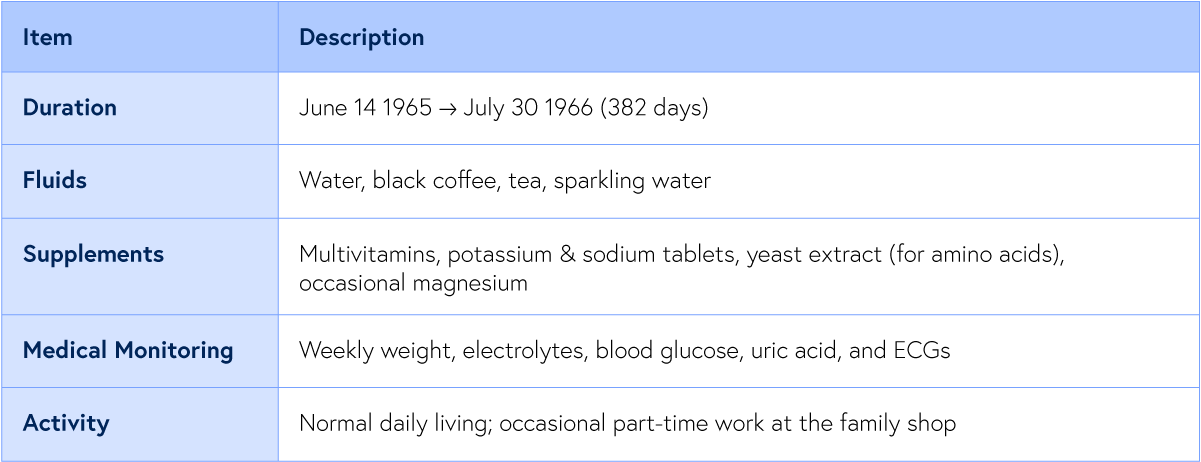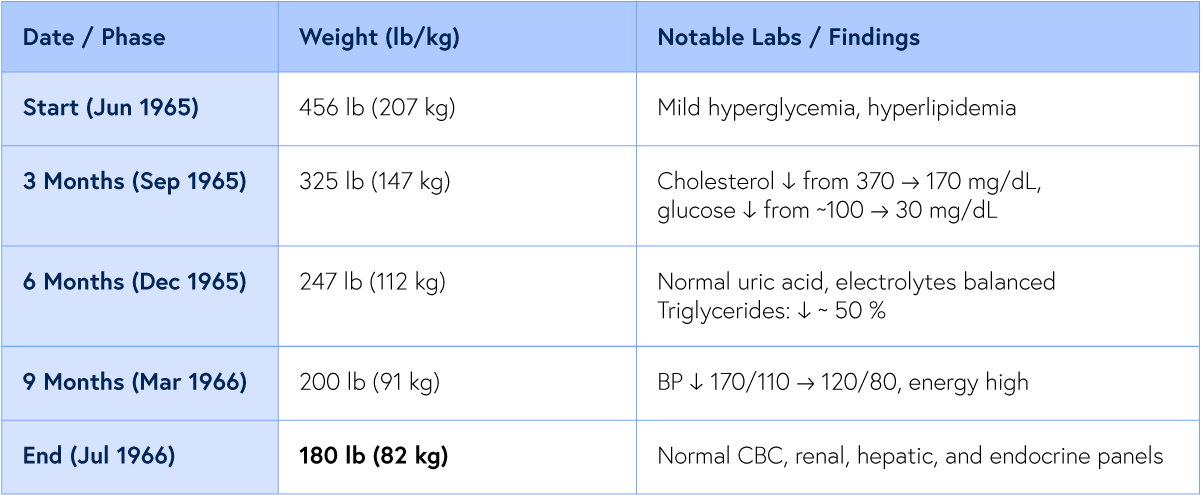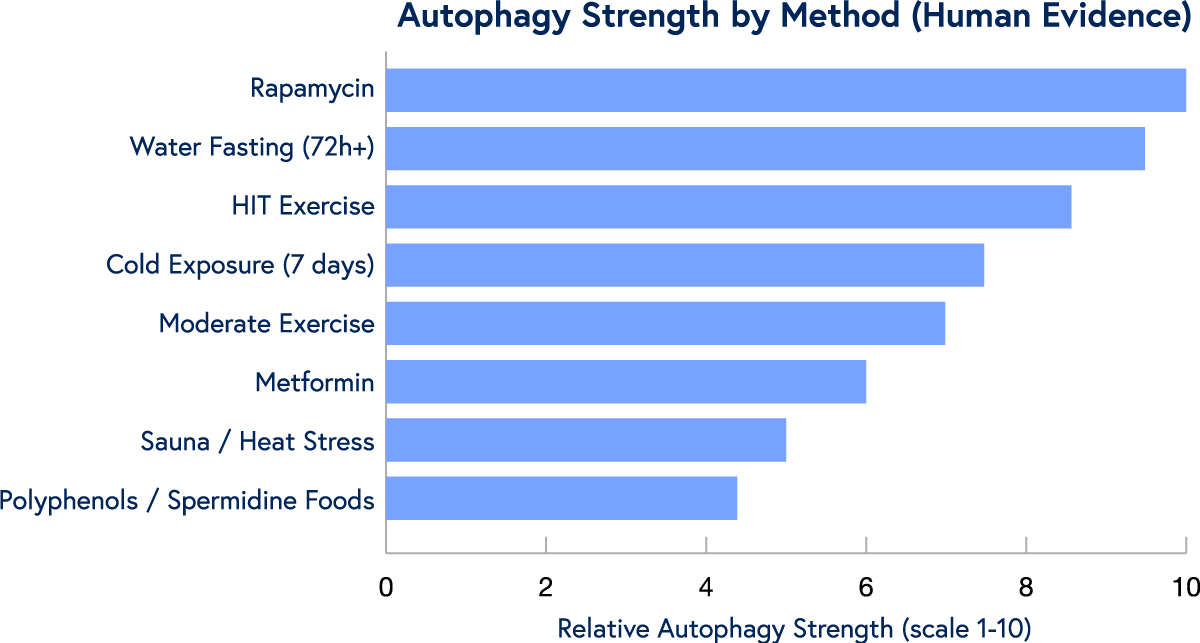The Power of Fasting (Part I)
Many times not doing is the most powerful thing you can do.
Fasting Reverses Disease Fast
Is it possible that modern abundance carries its own disease?
Dr. Haakon Strøm, during WWII’s insights
We live with ‘too much’ abundance, but not of a good kind.
Rest would do us much good.
Dr. Kevin Ham
We live in an age of overabundance. During WW2, when food became scarce due to forced food rations and the people of Norway had to eat a modest meal of vegetables, whole grains, fish and some fruit but no meat or dairy, incidence and prevalence of heart disease and stroke plummeted 30%. Many cancer rates also declined significantly. Upon freedom, with an abundance of food, the diseases skyrocketed back to previous highs.
What if we simply stopped overeating or skipped just one meal a day? Almost all of our modern day diseases would cease and disappear like Houdini.
A 382 Day Fast
I just stopped eating, and waited for my body to remember what it was.
Angus Barbieri
In 1965, in the coastal town of Tayport, Scotland, 27-year-old Angus Barbieri was at wits’ end. Weighing 456 pounds and 6 feet tall, his BMI exceeded 65, what is defined as ‘gross morbid obesity.’ Always short of breath, ankles swollen, barely able to stand and walk, he checked himself into Maryfield Hospital in Dundee in June 1965, in despair. Doctors planned a short 2-week fast to kick-start some weight loss.
But after a fortnight, his hunger disappeared, his mood lifted, and his blood tests were improving. He asked his physician, Dr. William Stewart, if he could keep going until he reached his proper weight.
That continued for months until it became the longest recorded therapeutic fast in medical history: 382 days!
Protocol Summary
The Slow Reversal of Disease
The slow, methodical, steadfast pace of the human spirit always wins more than the fast, yet brief pace of the rabbit.
Dr. Kevin Ham
The Weight and Lab Results
His doctors noted no muscle wasting beyond expected norms, likely because his enormous fat reserves provided steady energy and protein sparing through ketosis.
The case stunned the medical community.
The Postgraduate Medical Journal (1973; 49: 203–205) became one of the most cited fasting papers of the century. It proved the human body could sustain itself on stored energy far longer than anyone believed. It inspired later studies in very-low-calorie diets, fasting-mimicking protocols, and modern therapeutic fasting clinics.
Yet the authors added a caution:
“Prolonged fasting should not be attempted without close medical supervision. Nevertheless, this case shows the remarkable adaptability of human metabolism.”
Rapid Decline for Freedom
It is not those who can inflict the most, but those who can suffer the most who will conquer.
Bobby Sands
In the spring of 1981 in Northern Ireland, inside the cells of the Maze Prison, a small group of men decided to protest their being designated as criminals and demanded they be treated as political prisoners. As a protest, they stopped eating.
Bobby Sands, a 27-year-old thoughtful, red-haired poet and community organizer before his arrest for being part of the Irish Republican Army, stopped eating in protest on March 1, 1981. 66 days without food, he died on May 5, 1981.
The Biology of Starvation
Medical teams monitoring from a distance (the prisoners refused medical intervention) recorded the grim timeline of starvation:
Days 1–10: Glycogen gone, liver begins converting fat to ketones.
Days 10–30: Fat reserves deplete; muscle breakdown begins.
Days 40–60: Organ tissue catabolized; heart, kidneys, and lungs weaken; eyesight fails; hallucinations begin. By Day 40, Sands weighed less than 100 pounds. He could no longer stand.
After Day 60: Multi-organ failure, cardiac arrest, death. By Day 60, his heartbeat was faint; he drifted in and out of consciousness, reciting prayers and writing fragments of poems.
His last entry in his diary read:
“I am standing on the threshold of another trembling world. May God have mercy on my soul.
Royal Road to Healing: The 21 Day Fast
When the digestive fire rests, the spirit rises.
Otto Buchinger Sr.
Desperate for relief, Buchinger heard about a doctor in Freiburg, Dr. Gusta Riedlin, who treated incurable patients by supervising them by withholding food. Dr. Riedlin greeted him with his customary, “For three weeks, you will eat nothing. Only water, broth and rest. Trust nature.”
On his Freiburg clinic door was his signature phrase, which is still printed in naturopathy textbooks today: “Fasting is an operation without a knife.”
Riedlin told his students that to fast was to practice bravery in small doses. It was the daily rehearsal of death and rebirth, a sacred interruption of appetite, ego, and habit. “In hunger,” he said, “we meet both our weakness and our will.”
The first week was torture. In extreme pain from his disease and layered with hunger and silence, but by the 12th day, the pain in his joints began to ease. By the 18th day, he could walk unaided. On day 19, he began to eat some fruit, then vegetables and then carbs to break his fast. On the 21st, he wrote in his journal, “A miracle born of emptiness.’
He returned home whole and began to measure fasting’s effects with the precision of a naval logbook with blood pressure, pulse, uric acid, and joint swelling. He performed miraculous cures for his patients, including curing pain, high blood pressure, high triglycerides and arthritis. He added structured refeeding after the 3-week-long fast, herbal teas, meditation, and long walks by the lake. Fasting, he declared, must be holistic with whole body, mind and moral renewal.
His clinic on Lake Constance in 1920 expanded as his “Buchinger Method’ became Europe’s most respected therapeutic fast, treating arthritis, hypertension, diabetes, and chronic fatigue. He called it the “royal road to healing.” He lived a healthy life until 88, and his legacy continues to this day.
Autophagy
We live by constant destruction and rebuilding. Life is maintenance. If we forget that, we age not just in body, but in mind.
Dr. Yoshinari Ohsumi
The 2016 Nobel Prize in Physiology or Medicine was awarded to Dr. Yoshinori Ohsumi.
In the quiet basement of the University of Tokyo in 1990, peering through a microscope observed starving yeast, and the formation of odd bubbles forming inside them, eventually consuming fragments of the cell, it looked like cellular destruction, but on more careful observation, the cell was dismantling its damaged parts to recycle the amino acids for survival. This was repair through digestion.
He coined the term autophagy from the Greek auto, self, and phagein, to eat.
By 1992, Ohsumi discovered the genes that, when disabled, stopped the self-eating recycling mechanism and named these genes ATG1 to ATG15, the autophagy-related genes, and mapped the cell’s recycling plant —the process by which we renew ourselves at the cellular level.
When insulin and nutrients fall, mTOR, the molecule that commands growth, steps back and allows AMPK, the energy sensor, to step into command.
The cell removes malfunctioning mitochondria, misfolded proteins, and precancerous DNA.
In the liver, autophagy clears fat droplets.
In the brain, it dissolves amyloid tangles.
In the heart, it rejuvenates mitochondria.
In the immune system, it prunes old senescent cells.
Without autophagy, disease accumulates like fat and rust.
With autophagy, the body becomes antifragile, reversing disease, and becoming cleaner, smarter, and younger.
Animal studies show that stimulating autophagy can extend lifespan by 30-40%. Humans with high autophagy markers have lower cancer and neurodegeneration risk.
Long fasts of 48-72 hours can amplify autophagy by 8-10x, initiating stem-cell regeneration and immune renewal.
Even time-restricted feeding (TMF) of 16-18 hours daily activates a mild 1.5- 2x increase in autophagy, enough to clear the day’s cellular clutter before it turns into disease.
Ohsumi gives the quiet but stern warning that modern society, with its constant eating and over stimulation, “denies the cell its natural fasting state. Without emptiness, we drown in our own abundance.”
Renewal does not occur by adding but by subtracting. The body heals not by gaining but by letting go. When Ohsumi was asked for his advice on longevity, it was simply,
“Eat less, move more, and give your cells time to clean their rooms.”
11 Day Fasts - Dr. Alan Goldhamer
If you stop doing the things that cause disease, the body will heal itself.
Dr. Alan Goldhamer
Over in America, in Santa Rosa, California, in 1990, Dr. Alan Goldhamer, trained as a chiropractor, didn’t want to manage disease but instead remove its cause. Goldhamer had studied the early fasting physicians —Tanner with his public 40-day fast in New York and Buchinger with his 21-day fasts —and wanted to test their anecdotes with medical data.
His idea was simple, yet radical: create an inpatient facility for medically supervised water-only fasting. Just water and rest, monitored by physicians, nurses and charts.
The body’s response of over 20,000 who checked themselves in was astonishing!
A hypertensive who entered at 180/110 mmHg left two weeks later at 118/72.
His studies show 174 hypertensive patients who fasted for about 11 days, then refed 6-7 days on a plant diet, saw blood pressure fall 37 mmHg systolic and 13mmHg diastolic.
Severe high blood pressures dropped 60 mmHg systolic and all patients stopped medications.
A second study of 68 people with “borderline” hypertension found a 20/7 mm Hg drop, with 82 percent reaching 120/80 or lower.
Inflammatory markers, such as C-reactive protein (CRP) and TNF-alpha, declined sharply. Cholesterol normalized. Insulin sensitivity improved.
Goldhamer’s TrueNorth became the largest fasting database in the world, 20,000 water-only fasts over thirty years.
The cure is simple, the results are simply profound. Goldhamer modestly says,
“We let nature do the work, we just stay out of the way.”
Alternating 24 or 36 Hour Fasts - Dr. Jason Fung
The most powerful medicine for diabetes is not a pill but a fast.
Dr. Kevin Ham
A few decades later in 2018, a brilliant doctor in Toronto Canada, Dr. Jason Fung, put three men who had long-standing severe diabetes on a supervised, alternating 24 to 36-hour fasting protocol with whole-food meals in between.
For half a century, diabetes was considered chronic. Medications were added over the years until insulin was a mainstay, with possible blindness, kidney dialysis or leg amputations.
But these patients proved that all was false.
Patient A: 5 Days to Normal
Age / Profile: 52-year-old, 5-year history of type 2 diabetes; injecting 70 units of insulin daily plus metformin.
Fasting protocol: 24-hour fasts, three times per week, alternating with low-carb whole-food days.
Day 1–3: insulin doses halved; glucose dropped steadily from 14 mmol/L (252 mg/dL) → 7 mmol/L (126 mg/dL).
Day 5: insulin discontinued entirely. No hypoglycemia.
Month 1: fasting blood glucose stable between 5–6 mmol/L (90–108 mg/dL).
Month 3: HbA1c ↓ from 12.0 → 7.5 %; weight ↓ 10 kg (22 lb); waist ↓ 13 cm.
Month 6: off all diabetic meds; energy “better than in twenty years.”
Patient B: 9 Days to Normal
Age / Profile: 60, diabetic for 10 years, on insulin + two oral agents.
Fasting protocol: 36-hour fasts on Monday, Wednesday, Friday.
Week 1: insulin tapered from 60 → 20 units/day; fasting glucose fell from 11 → 6 mmol/L.
Day 9: last insulin injection; continued oral metformin briefly.
Month 2: HbA1c 7.2 → 6.0 %; weight ↓ 11 kg (24 lb); waist ↓ 13 cm.
Month 6: all medication stopped; fasting glucose consistently < 6 mmol/L (108 mg/dL).
Patient C: 18 days to Normal
Age / Profile: 67, 15-year diabetic, on multiple daily injections + statin + ACE inhibitor.
Fasting protocol: 24-hour fasts three times weekly, later extended to 36 hours.
Week 3: insulin stopped after 18 days; oral meds halved.
Month 2: HbA1c 6.8 → 6.2 %; weight ↓ 9 kg (20 lb); waist ↓ 13 cm.
Month 10: still off insulin; blood pressure normalized; HDL ↑ 10 %, triglycerides ↓ 25 %.
Reflection
Empty your heart
Abstain from food and wine
Let the abundance depart
To restore your original design
Dr. Kevin Ham
Life is simple and profound. Reflect upon how the emptiness of the vessel is the most useful part of the vessel. Inside your body is a filling and emptiness. To be full, you must empty.
Ease the Heartache of Loved Ones
What is the big bottleneck of Diabetes? Glucose or Fat?
Dr. Kevin Ham
If you have friends or family, please forward my newsletter to them and ask them to sign up. I’d like to help many people reverse and heal their disease.
Life-Changing Question
What can you subtract in your diet or your life for 30 days to be whole and full again?
Within the law of multiplication hides the fact that you must subtract to multiply. Not just subtract one thing, but 80% of the things you do, you think, you eat to find the 20% that give you the bulk of your results, the 80%. This is the 80/20 principle and it resides in all facets of life and nature.
Next week—
The Power of Fasting (Part II)
Many times not doing is the most powerful thing you can do.
Subscribe to my Compounding Wisdom newsletter and start transforming your life.





